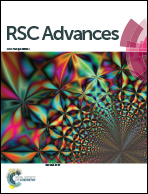New structural hypostases of the A·T and G·C Watson–Crick DNA base pairs caused by their mutagenic tautomerisation in a wobble manner: a QM/QTAIM prediction†
Abstract
It is widely known that canonical DNA base pairs preserve the Watson–Crick (WC) scheme of pairing that enables accurate transfer of genetic information across generations. Herein, we firstly present a discovered biologically important ability of the classical A·T(WC) and G·C(WC) nucleobase pairs to tautomerise into the wobble (w) H-bonded mismatches – A*·T↑(w), A·T*O2↑(w), A·T*↓(w) and G·C*↑(w), G*·C↓(w), G·C*↓(w), G*·C↑(w), respectively, containing mutagenic tautomers of the bases (denoted by asterisks), and vice versa. QM and QATIM calculations show that these non-dissociative tautomerisation processes, which are quite fast in comparison with the rate of the DNA replication in the cell, are controlled by the highly stable and highly polar transition states – tight A+·T−, A−·T+, G+·C− and G−·C+ ion pairs, which are formed by the protonated and deprotonated bases. The estimation of the populations of the tautomerised states of the A·T(WC) (6.1 × 10−9 to 1.5 × 10−7) and G·C(WC) (4.2 × 10−11 to 1.4 × 10−9) base pairs in the continuum with ε = 4, corresponding to the interface of the protein–nucleic acid interactions, points to their involvement in the process of the nucleation of the spontaneous point replication errors in DNA, arising with frequencies from around 10−11 to 10−9 errors per nucleotide replicated. The presented concept of the mutagenic quantum wobbling of the canonical A·T(WC) and G·C(WC) nucleobase pairs as an intrinsic property resulting in their tautomerisation allows us to explain the increase in the frequency of point mutations induced by 2-aminopurine, and also to interpret satisfactorily the NMR experimental literature data that show a slow exchange between the G·P(WC) Watson–Crick-like base pair with a corresponding wobble pair, which includes the 6H,8H-3,4-dihydropyrimido[4,5-c][1,2]oxazin-7-one (P) mutagen. These findings significantly expand the horizons of the classical Watson–Crick tautomeric hypothesis of spontaneous point mutagenesis. Collectively, our investigation revealed the hitherto unknown ability of the canonical Watson–Crick DNA base pairs to switch into the wobble mismatches with mutagenic tautomers, clarifying the nature of genome instability. Moreover, this paper reveals new facets of the Watson–Crick tautomeric hypothesis of the spontaneous point mutagenesis arising at DNA replication, and significantly broadens the possibilities for the rational design of chemical mutagens with a targeted action, which could be interesting for medicine, synthetic biology and biotechnology.


 Please wait while we load your content...
Please wait while we load your content...